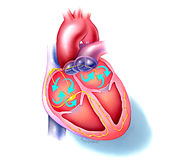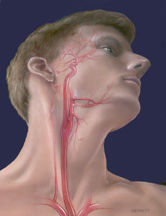|

Atrial
Fibrillation (also called AF or A Fib) is a common
heart rhythm disorder caused by a problem in the conduction
of electrical impulses in the upper chambers, or atria, of
the heart. A Fib and other rapid heartbeats that arise in
the atria, or in the juncture between the atria and the lower
chambers (ventricles) are called "supraventricular tachycardias."
More than 2 million people in the U.S. have A Fib, and
about 160,000 new cases are diagnosed each year. A Fib
is uncommon among young people, although it can occur in people
of any age. The likelihood of developing the condition,
however, increases as we get older. After age 65, between
3 percent and 5 percent of people have atrial fibrillation.
Approximately 9 percent of people who are age 80 or older
have the condition.
Atrial flutter (AFL) is another supraventricular (above
the ventricles) tachycardia (rapid heartbeat) that is
very similar to atrial fibrillation. Instead of many
disorganized signals, however, AFL is caused by a single
electrical wave that circulates very rapidly in the
atrium.
What Causes A Fib?In A Fib, the electrical signals that coordinate the muscle
of the upper chambers (atria) of the heart become rapid and
disorganized, typically causing the atria to beat faster than
300 beats per minute. (The normal rate when the heart is at
rest is about 60 to 80 beats per minute). When this happens,
the atria may contract poorly and no longer effectively force
blood into the lower chambers (ventricles). As a result, the
flow of blood to the body may be reduced. Atrial fibrillation
may occur from time-to-time, or it may be a permanent condition.

Types of Atrial FibrillationParoxysmal A Fib. Episodes of A Fib that end
spontaneously are called paroxysmal A Fib. This type
of atrial fibrillation usually comes on suddenly, and
its symptoms can range from mild to severe. The irregular
heart rhythm may last for a few seconds, minutes, hours
or longer before the heart resumes a normal rhythm on
its own.
Persistent A Fib. With this condition, the
irregular heart rhythm continues indefinitely unless
it is treated. According to a study conducted by the
Canadian Registry of Atrial Fibrillation (CARAF), many
patients with paroxysmal A Fib will progress over the
course of several years to persistent A Fib.
Permanent A Fib. In this situation, normal rhythm
cannot be restored.
Health Risks
In younger people who have no other disease that affects
the heart, atrial fibrillation or flutter usually is not considered
serious. Some people with atrial fibrillation, however, are at increased risk of stroke,
heart failure or heart muscle disease.
Sometimes, A Fib can damage heart muscle and alter the normal
electrical signals to the heart. This may change the patterns
of contraction and relaxation of heart muscle. This is known
as electrical remodeling.
According to the Framingham Heart Study,
people with A Fib or flutter
have a 3 to 5 times greater risk of stroke, especially
individuals who are older than 65, have already had
a stroke, or have high blood pressure, diabetes or congestive
heart failure. An Increased Risk
of StrokeDuring an episode of A Fib
or AFL, the heart muscle does not contract normally to
force open the heart valves that pass blood from the
atrium to the ventricle. The valve opens passively, but
some blood may not enter the ventricle as it should. Instead,
it pools in parts of the atrium, increasing the risk that
clots will form in the stagnant blood. Even small blood
clots can cause problems if they leave the heart and are
released into the general circulation. They may clog arteries
in the body and disrupt the blood supply to vital organs.
A stroke occurs when a clot lodges in the arteries that supply
blood to the brain.
Atrial Flutter
|
|
Atrial flutter (AFL) is very similar to atrial fibrillation.
Both conditions are types of supraventricular (above
the ventricles) tachycardia (rapid heart beat). This
means that the upper chambers (atria) of the heart beat too
fast. This produces muscle contractions that are out of sync
with the lower chambers (ventricles).
Sometimes, the muscle of the atria contracts, or beats, as
many as 250 to 400 beats per minute. Usually the individual's
pulse may be less rapid. This is because the heart has a built-in
"gate" (the atrioventricular (AV) node) that controls the
number of electrical impulses that travel from the atria to
the ventricles. 
|
The pumping of the heart is controlled by steady electrical
signals produced by the heart's natural
pacemaker,
the sinoatrial (SA) node, located in the right atrium. The SA
node passes signals through the atria to the atrioventricular
(AV) node. The AV node is the electrical "gate" or "junction
box" that receives the signals and passes them along to the
ventricles. When the AV node receives signals that are too rapid,
such as in atrial flutter (and A Fib) its job is to slow them
down so that there will be enough time for the blood in the
atria to enter the ventricles. The signals passed from the AV
node travel along fibers called bundle branches, causing the
ventricles to contract and pump blood out to the body.

|
